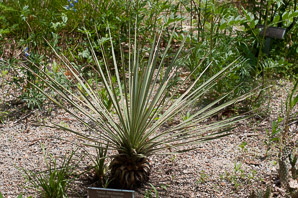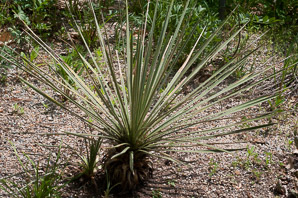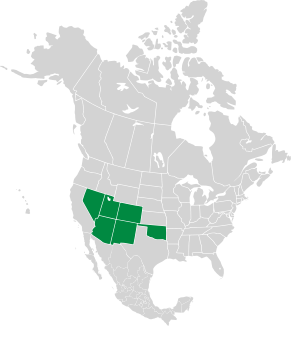
|
Yucca harrimaniae Trel. Spanish bayonet, New Mexico yucca
Linnaeus' choice of the word Yucca is unclear, since the only existing meaning for the word at the time referred to the unrelated cassava plant, but harrimainiae acknowledges the philanthropic contributions of railroad tycoons Mr. and Mrs. Edward Henry Harriman, who funded expeditions. Identification: These yuccas are found in groups of one to twenty tufts, each about 12-39″ (30-100 cm) around. Each tuft consists of stiff, narrow, sharp-pointed leaves about 4-20″ (10-50 cm) × ¼-½″ (7-14 mm). Flowers are urn-shaped, white, cream, or greenish white, sometimes tinged with purple, with purplish buds. They have 3 petals and 3 sepals. Flowers 1½-2″ (4-6 cm) long × ⅝-1¼″ (1.6-3.5 cm) wide. Seed pods are cylindrical, 1¼-2″ (3.5-6 cm) long × ½-1″ (1.5-3 cm) in diameter. The closely similar species Yucca angustissima may be the same as this species, as discussed here. See the Yucca page for a comparison with other yuccas. Online References:
Benny Møller Jensen's Denmark site, www.bennyskaktus.dk Wildflowers, Ferns & Trees of Colorado, New Mexico, Arizona, and Utah The United States National Parks Service Plants for a Future, a resource and information centre for edible and otherwise useful plants References:
Irish, Mary & Irish, Gary, Agaves, Yuccas and Related Plants: A Gardener’s Guide, Timber Press, 2000, p. 259 Ingram, Stephen, Cacti, Agaves and Yuccas of California and Nevada, Cachuma Press, 2008, p. 170
Yucca harrimaniae description by Thomas H. Kent, last updated 25 May 2020. © FloraFinder.org. All rights reserved. |
5/22/2010 · Garden in the Woods, Framingham, Massachusetts 5/22/2010 · Garden in the Woods, Framingham, Massachusetts Range: Zones 5a-10a:
|




